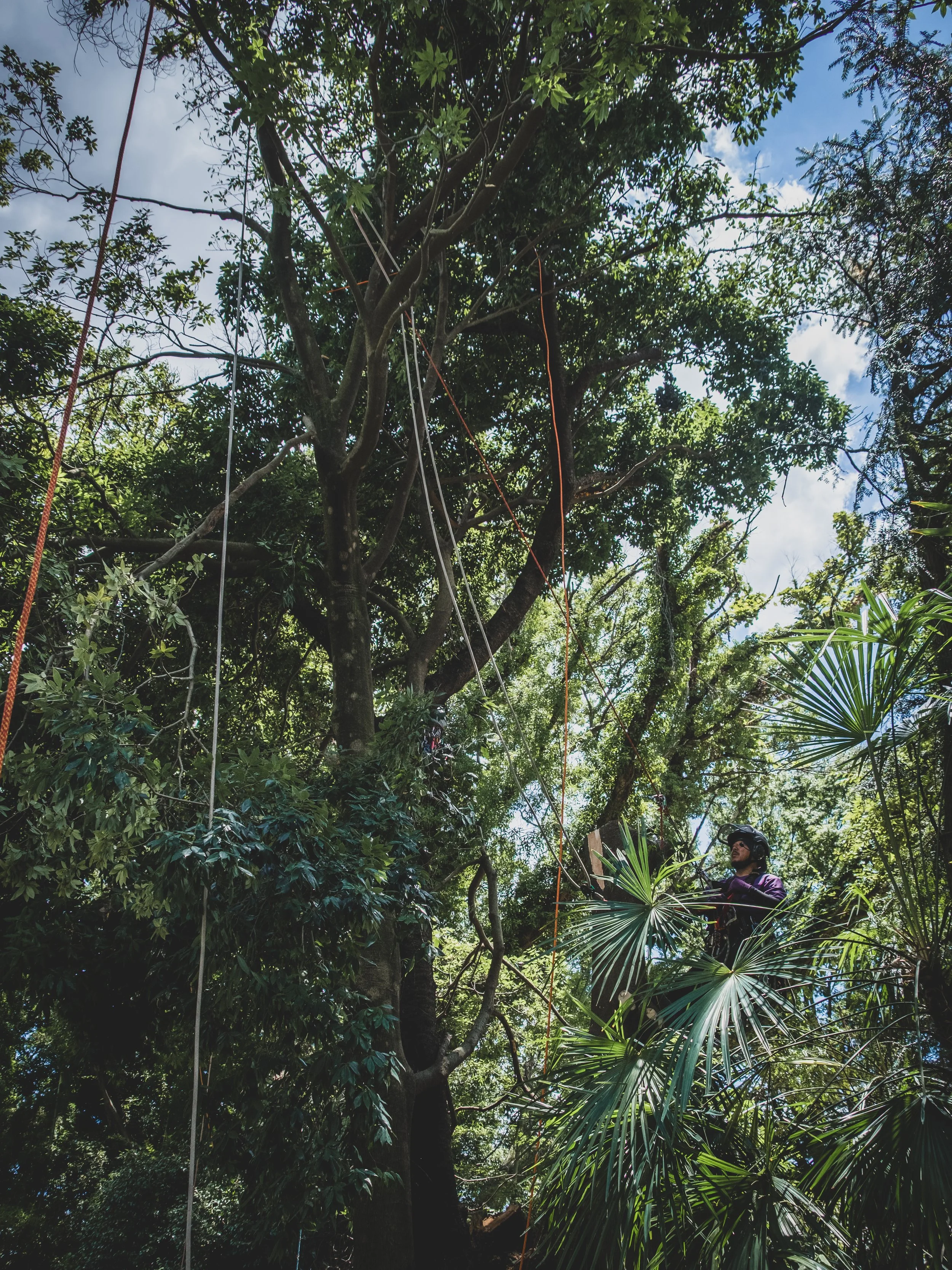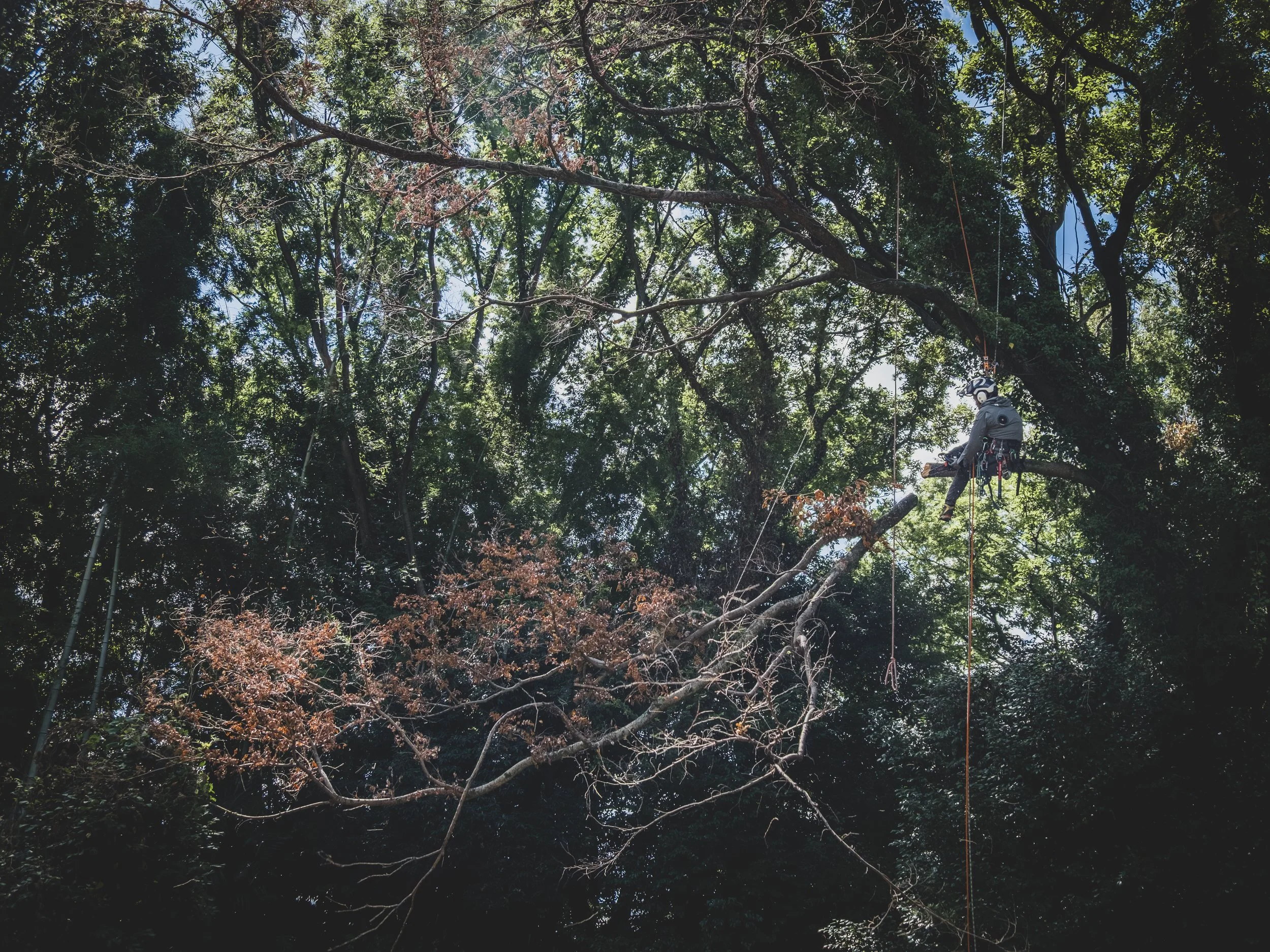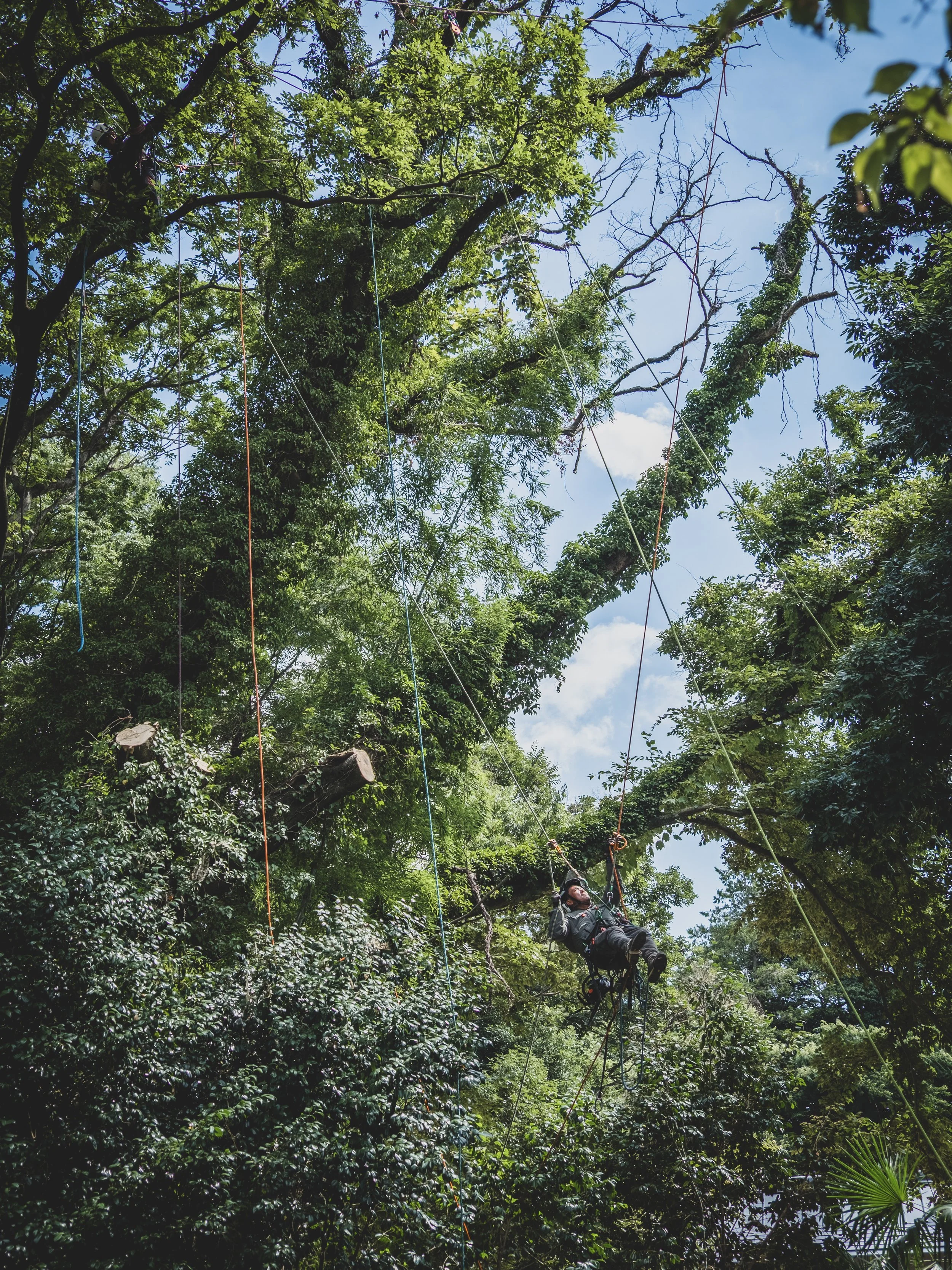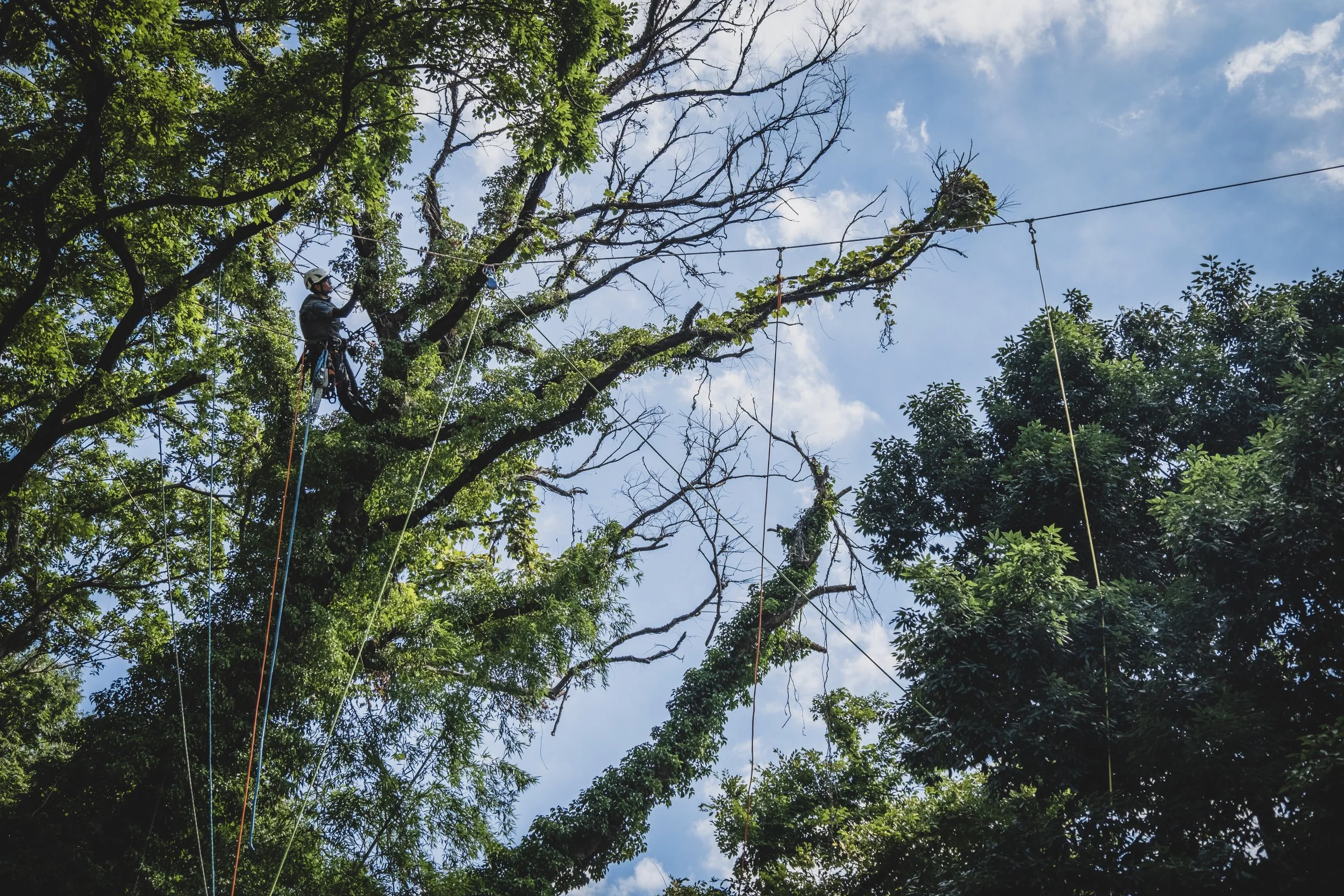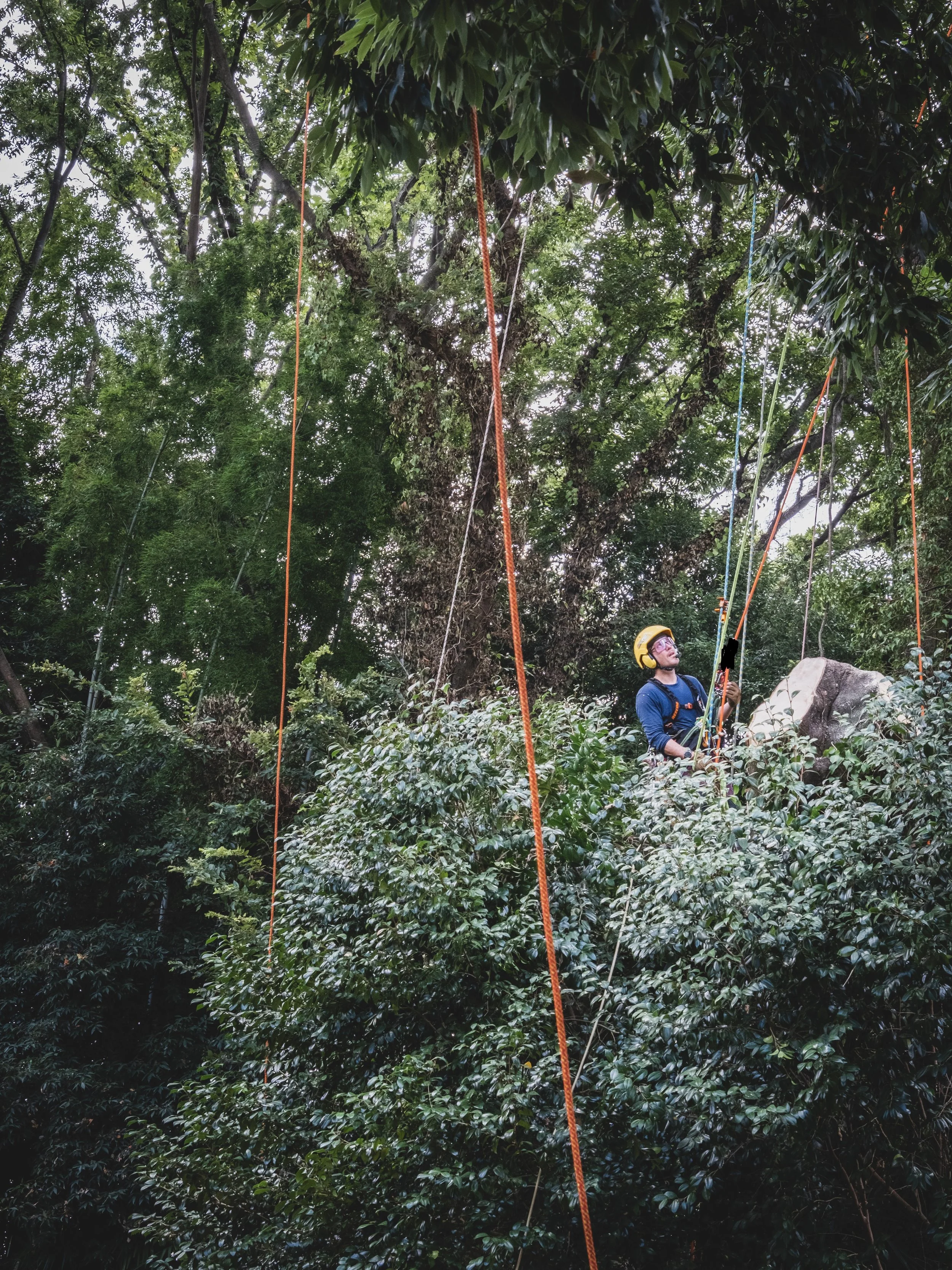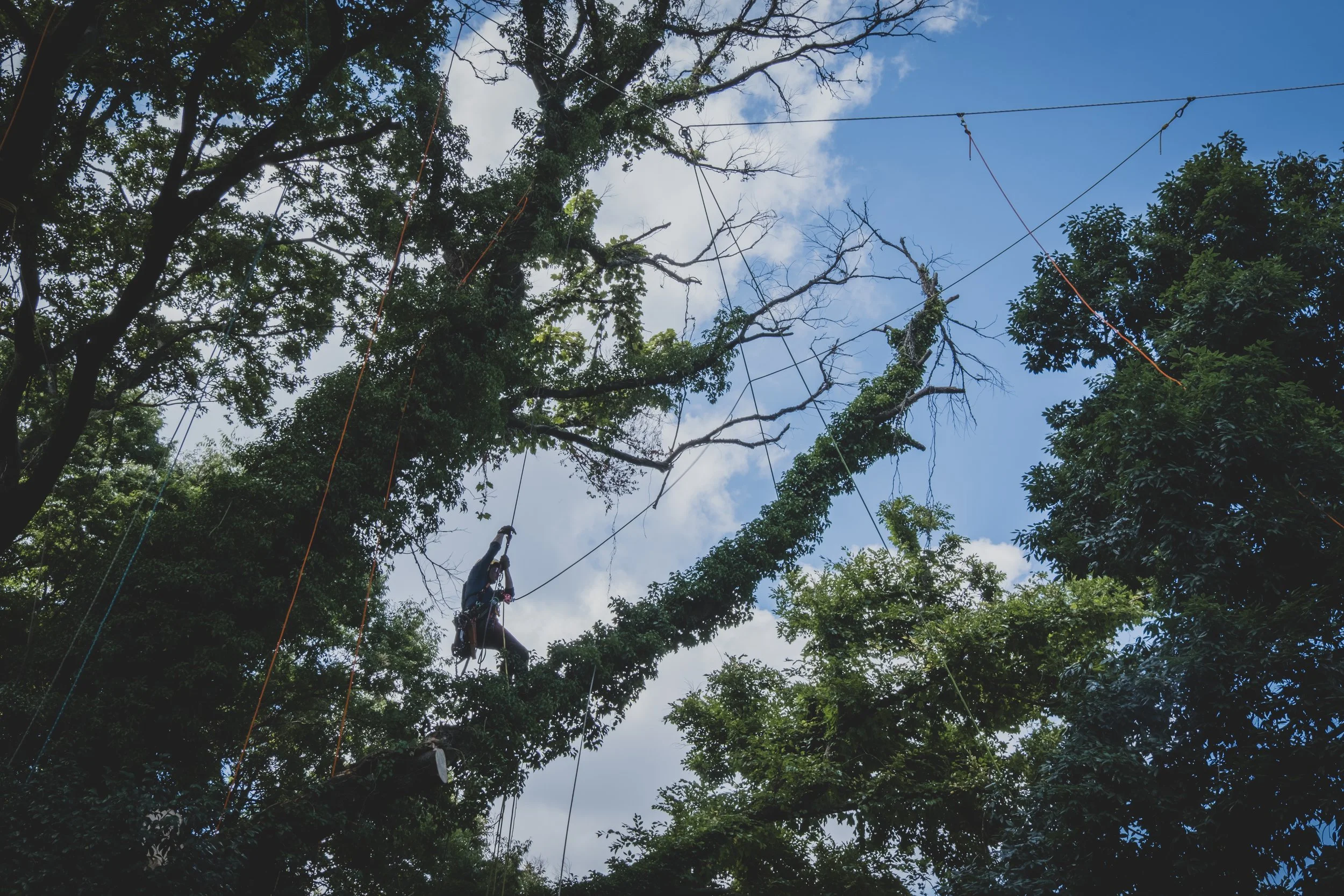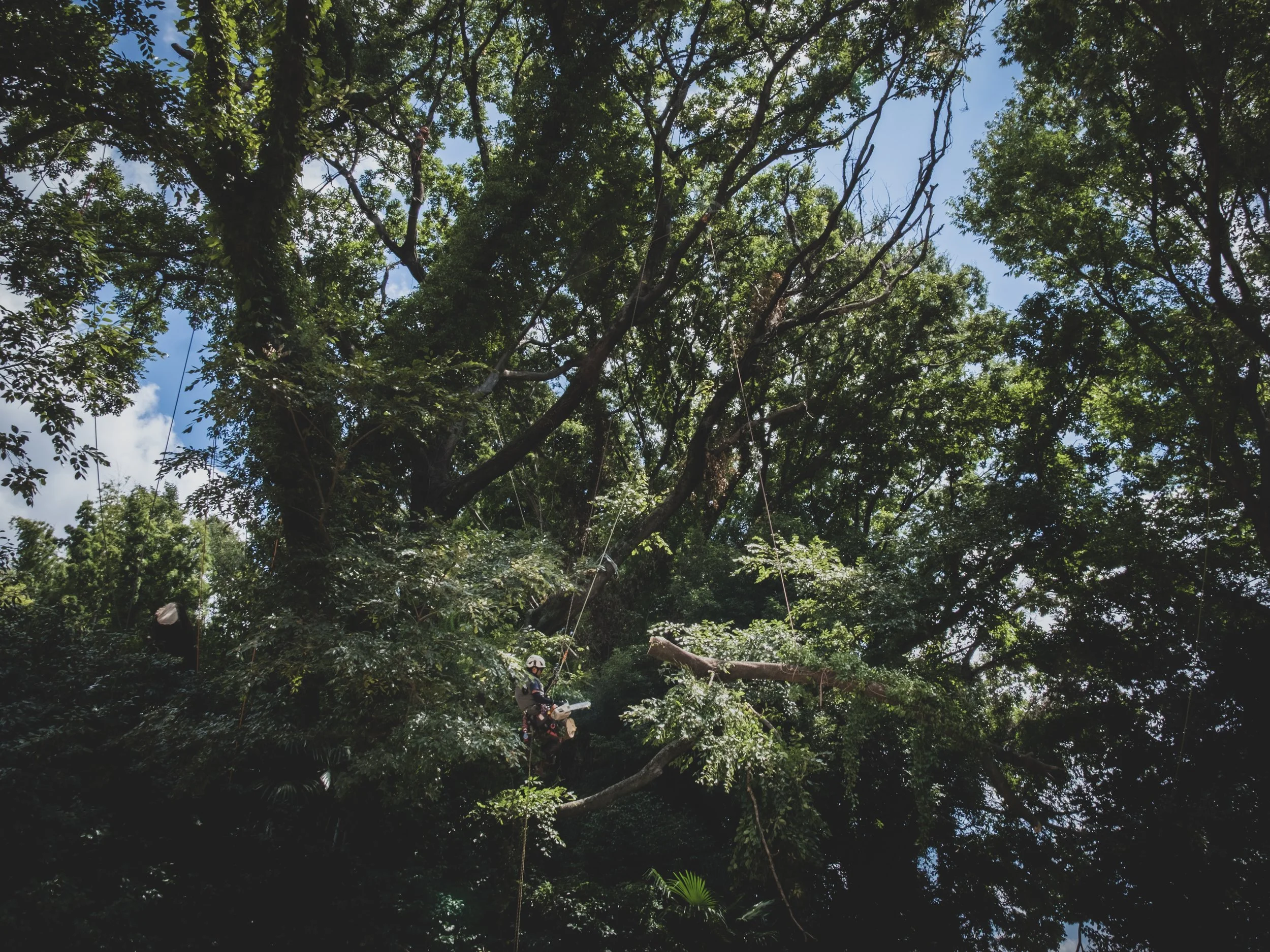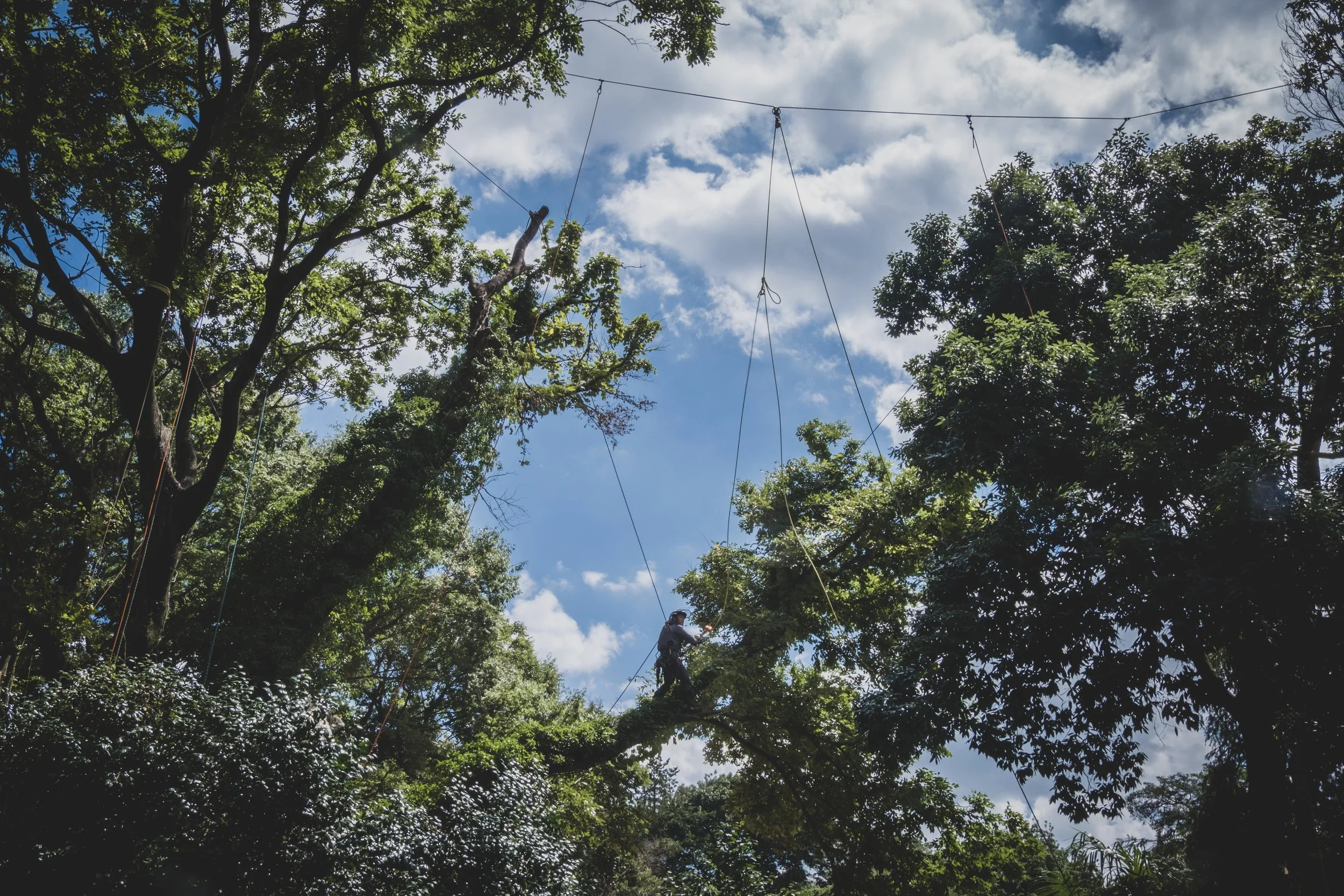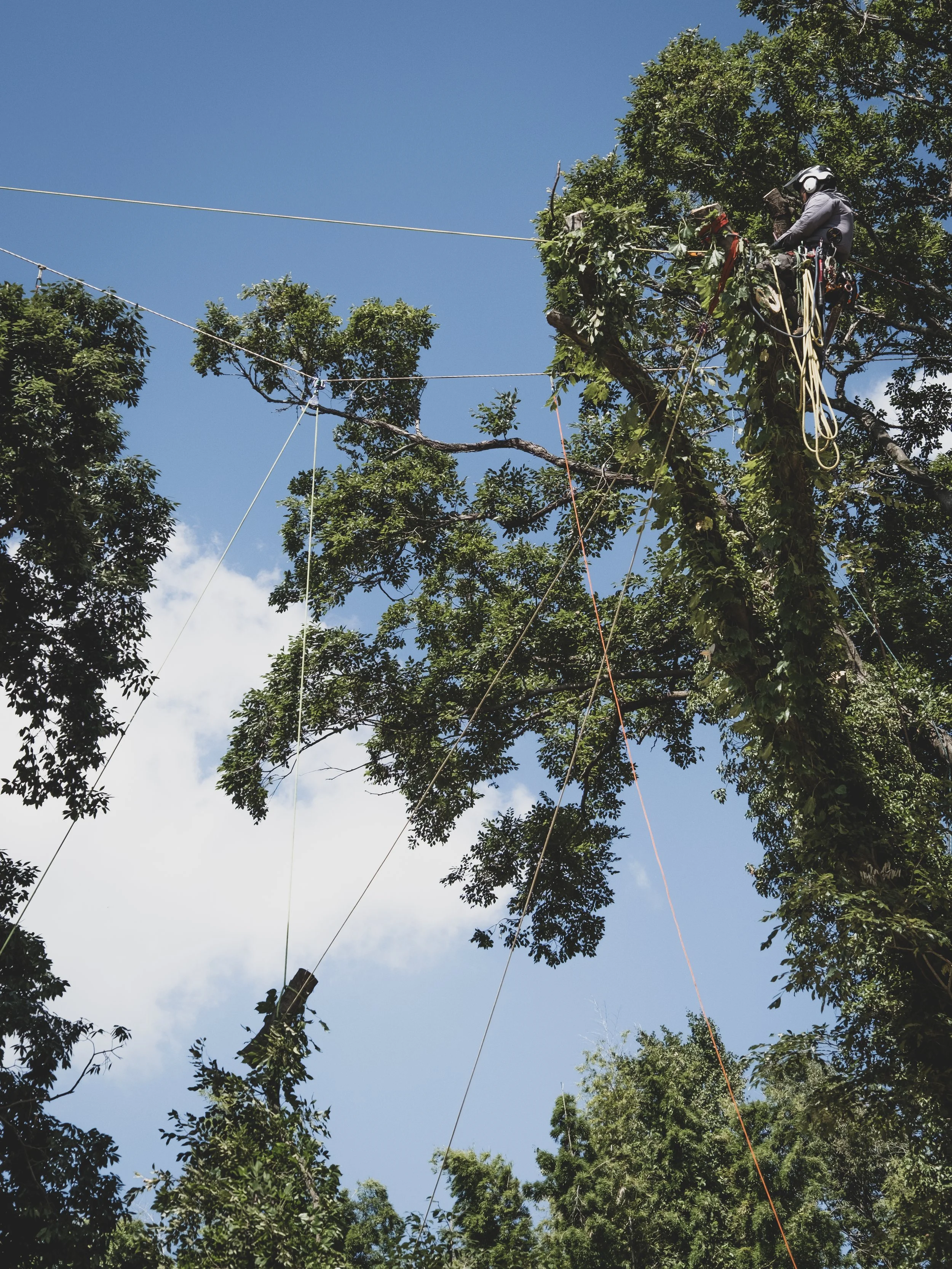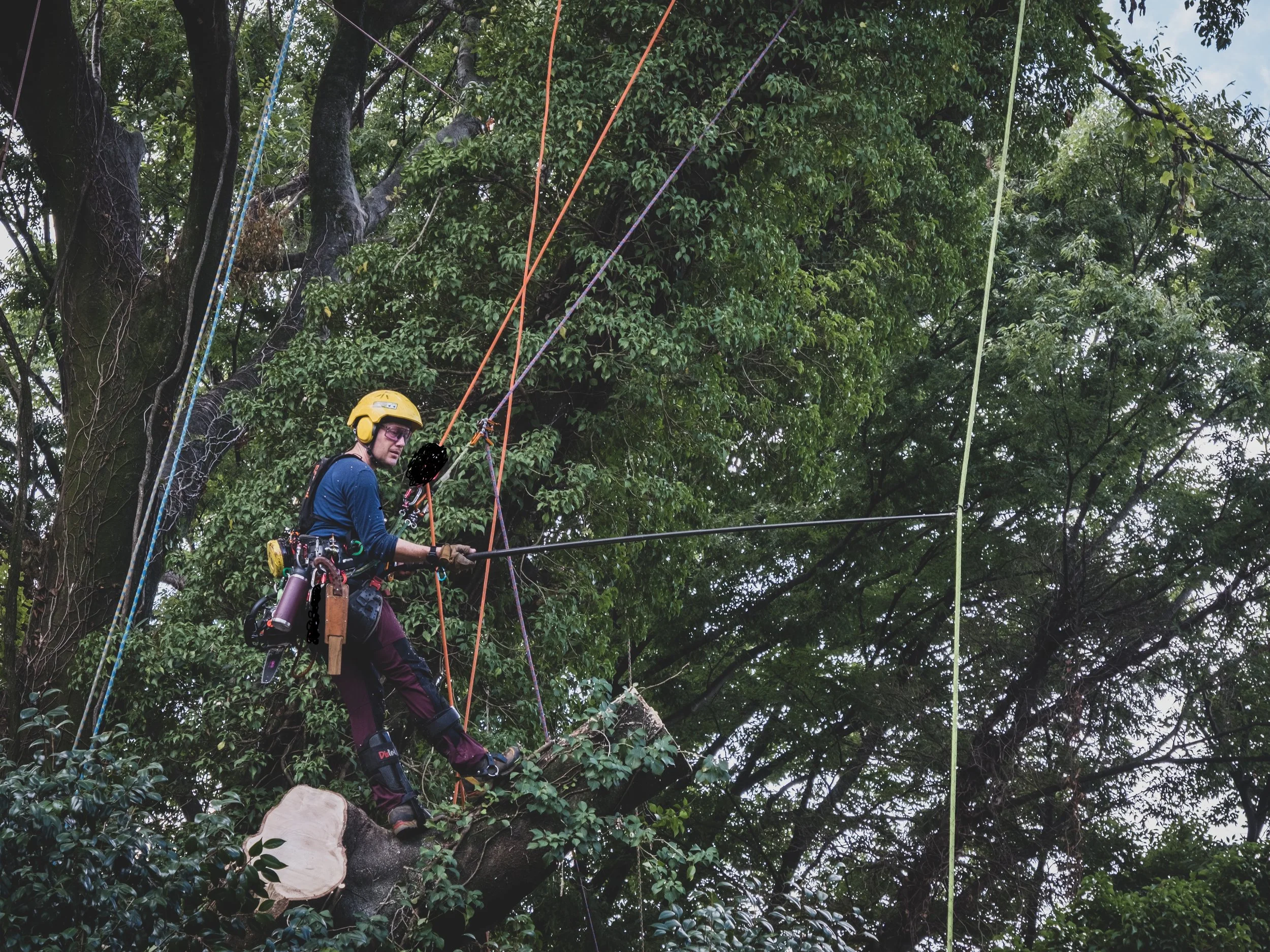Yokohama Miyabi
A r e p o r t o n b r a i d e d e l e g a n c e
The trunk wood of Celtis sinensis grow to look like Elephant legs, large, lumpy and wrinkled yet the bark is smooth, like they have maintained a good moisturizing routine throughout their lives. And the branches turn from Elephant legs immediately into Elephant Trunks, and grow in wild directions, with no seeming concern to want to be close to one another. The crown of an Enoki is spacious, and being up there gives the sense of wild vistas, inviting rope ideas to try and bring it all together. For a novice Arborist these trees can be intimidating. With twenty years experience it felt like a real problem to solve.
This job was another case of ‘if you don’t look up then the problem wont be there’. For some reason humans, even conscientious ones, seem not to SEE trees, until its too late. Most of the crown of this Enoki spread over dozens of well maintained family grave plots, the resident monk had noticed bits of the tree falling onto them, so wondered if it was time to do something. Three branches were of great concern and one in particular looked like if you sneezed in the wrong direction it was liable to dislodge. Not a small branch either, eight meters long, twenty centimeters in diameter. With no anchor points in the tree, how could I access to this weakened branch and cut it without it swinging wildly and breaking into sections? Even though the work should have been carried out years ago I would get the blame if it smashed gravestones while attempting to remove it, . There seemed to be two major rope design solutions and a third idea that I’m in gratitude to Iwamoto san for implementing. His idea was to erect scaffolding and cover it with plywood sheeting under the points of most concern and this ended up measuring into one section twenty meters square and a smaller second section for three other dead Sakura trees. The cost would be substantial yet it seemed to us like a no-brainer, we just had to convince the temple of the safety concerns. A tall tulip tree stood forty three meters away from the Enoki, and several Zelkova to the other side, so it seemed that a highline was plausible. A climbing inspection showed that while seventy percent of the tree needed removing (two of three major scaffolds), one had enough life to use as potential anchoring. In fact we agreed to leave this section intact. With this in mind and the rope and ground solutions planned out the pricing estimate was given to the temple. The scaffolding proved quite difficult to design as there would be weight pressing down into the gravestones. One negative thing about me is that I assume I’m capable of more than I am, and was convinced to do the job with or without it, declaring “it’ll be OK”. A few weeks passed as Iwamoto san calmly worked things through with the scaffold company, during which time heavy rain caused the eight meter long branch to dislodge and fall several meters, luckily hanging up on a lower branch. One and a half meters of the tip broke off and damaged gravestones so it was decided without question to build up the scaffolding. The temple realized at this point the danger of the tree, so the high price became a little easier to accept.
A highline runs in one dimension, between two major anchors. When possible it should be tied off away from the major anchor tree, forming a triangle shape and allowing the pulling force to load compressively into the trunk, towards the floor. The Enoki branches were long and traced many directions, so I decided to rig a moveable pulley on the highline, which would accomodate being rigged into a Span. The Working End of the Span could be tied off at a number of points and pulling the highline from left to right would pin-point the angle of attachment, removing unnecessary pendulous movement. For positioning I decided to rig climb lines into the (a) live section of the Enoki, (b) a Zelkova that stood twenty two meters away on the far side of the gravestones, and (c) to place four lines at four meters distance apart, two either side of the pulley on the highline. It would give the climber quick access to positioning options, depending on how the tree dictated the cutting order. There would be no faffing about mid-work flow, the climber would be able to choose from seven positions around the tree and free floating space.
The practicalities of building and running a new system as the clock ticked away was slightly concerning, so I invited a team of Arborists that I hold in high regard, lets call them the Arborist Avengers, introduced as follows; Makoto, Yasu, Shun, Kudo and Ciro as well as two guys that wanted to come and study, Jinbo and Matt, who ended up pitching in and helping a lot too. Iwamoto san, who initially asked me to help with this job, is a novice rigger but his careful planning helps out so much and we ended up with a large team of creative and enthusiastic individuals.
Day One
Begin by introducing members to one another and transport all equipment into the site. Work overview and critical safety concerns explained while laying out foundation of the system design, the highline. I choose to call it ‘Noren’, which is a Japanese cloth hung over the front of shops. I thought a visual clue may be helpful for those that couldn’t quite visualize the idea. It’s better to be creative here, to share everyone’s insight, before fully committing to the original idea. Which can sometimes be tricky as voices are naturally different in strength. As the saying goes, the loud voice isn’t always the clearest, and I keep in mind to listen to everyone, however insignificant the thought or idea may seem. There are times my perception is wrong and the reason for bringing together such a group is to learn as we work. A whiteboard is used to highlight shapes, angles, cutting scenario ideas and order of works etc, and of course to highlight which equipment will be used and where. Keeping in mind that angles need to change as the cutting begins, try to speak in a time frame, and try to be as granular as possible without overloading people, Anyway, the highline idea seemed to be solid so we separated out equipment and spoke about the particulars of compatibility. For example, I wasn’t sure how to attach the hub-pulley to the highline, Shun decided that a girth hitch would suffice, and no one had arguments any other way. The group split into three teams, one for each highline anchor and a third to set rigging and climbing anchors on the far side of the graves. We managed to set the highline, far side rigging and climbing and a winching system within four hours, so had a little time left over to start removing three dead Sakura trees. Using a Double Whip Tackle from the highline with a ratchet pulley to allow pieces be lowered by hand, which gives a light high cycle feel to the work flow. It’s a lovely system. Yasu climbed the tangled mess.
Everything seemed in order, a good days work.
Day Two
The backside of the tree had several sections that needed removing and were unnecessary for rigging points. Shun showed off his ported Echo CS2511, ripping through the large branches like butter.
The work was light in scope today so gave us a chance to see how the team could gel together. Shun used a number of different rigging ideas, even joining the rigging and winch line together to create a Span system. It was cool to see the pieces float into the final winching location with no effort at all. Without saying so we were able to practice team communication and to ensure that ropes and anchors wouldn’t be overloaded when winching into them.
A final climbing inspection of the highline planned out the full scope of its potential and we picked up areas that would need additional rigging points. Along with the multiple climb lines, having access to preset rigging points would ensure a smoother work flow.
Day Three
Two climbing teams working branches over the gravestones, passing cut material to the winch system. The tree was large enough for neither team to get in one another’s way to the point where we couldn’t even see each other. Being covered in climbing plants accentuated the distance. Makoto, Yasu and Matt started by lifting the broken dead branch which had fallen and caught on the lowest branch. Makoto told me the story about it.
The thicker part of the branch was around twenty-five centimetres in diameter and about a meter up from the end it had split on the impact from falling. Lifting the whole section was feasible in one go with the two rigging points but the delicacy of the branch made us think it may break while being lifted. We decided to lift it out in two pieces, which meant that one had to be secured in place for risk of falling. It was a little tricky to set additional re-directs and keep moving the tie points around, it took quite a while. The two other live branches were very long and we decided that cutting them in one go would clear enough space for them to be winched out. It went smoothly and we were a little surprised at the speed of completing such a large section of the tree.
Paul, Shun and Ciro worked on the highline side, first by clearing more of the branch that Shun begun cutting on day two. Paul climbed directly into the highline then picked up one of the ropes that was tied into the central point on the Enoki. He transferred between lines moving toward the first work area. The highline pulley was adjusted to suit the cutting then tied off again. We had been able to practice enough over the first two days to get the height, angle and pre-tension correct. Highlines are notoriously difficult and it takes time to learn about the inherent weakness when overloading them. You need height, but not tension. Cranking winches to raise the height before cutting begins means that rope and anchor points are easily overloaded. A fourteen millimeter class 2 double braid meant high strength and low stretch, it would do the job perfectly. We would be on the limit of height because of the forty three meter distance between anchor points so better to cut smaller on the upper sections and leave some slack to absorb potential shock loading. Enough space was cleared and we decided to remove the lower heavy trunk on a separate rigging system on the last day. Climbing was easy, re-adjusting the highline pulley was easy, cutting went smoothly. One part of the upper crown wanted to fall both sides of the highline, so we put in a simple redirect and pulled the highline to one side, giving it two-dimensions, and enough space to cut the top in one piece without getting hung up. When needed the pendulum was managed with a Control Line or Span, both easy to rig mid-work with no nuisance to the work flow. Shun took over climbing duties in the afternoon, he is a smooth climber and slick worker, safe and efficent. It was fun watching Shun and Ciro, who had never worked together, begin to gel as a team.
The memory of working on site everyday often blends into one continues buzz of reflections, yet days like this stand out. Was it the team dynamic, the preparations or just luck? I’m not sure of that but I think for us all it was a memorable day, one that stands out to us as craftspeople and one to take inspiration from moving forward with our professional lives.
Takubo Koko kindly came over in the intense heat to take photographs, the ones that are featured in this article. On the afternoon of day three while we drove to buy ice-cream, she remarked that the work site looked MIYABI 雅, a word that I hadn’t come across before. It means elegance and was used in the Heian period in Japan. Heian, spanning from 794 to 1185 AD, is considered a golden age of classical Japanese culture and is known for its peace, artistic development, and the rise of a distinctly Japanese identity. Quite a compliment to give a foreigner.
Other Days & Things
There was some more highline rigging on day four, which was completed in a couple of hours. The highline was broken down and a twin Double Whip Tackle set for the heavy trunk wood. One half dead Sakura tree that stood on the far side of the temple surrounded by gravestones needed removing so it was a chance to rebuild the highline. I took Matt and Jinbo and we built it within an hour. It used a Ratchet Double Whip, same as the first day, but with only one climb line. Basically identical but I swapped out the girth hitch on the hub for two friction hitches, always tinkering to get better results. It struck me that the use of this may be important moving forward. Back at his home town of Nara Shun had a large Maple tree to work on, dead and with no anchors. As soon as he returned his team completed it using the NOREN highline. Techniques are more than technical theory, they help our lives, make it fun and safe, and most of the time that seems to be all we are looking for.
Shun’s ‘Oyaji Stick’ was great for this job.
ODSK continue to run highline workshops, please get in touch to learn more about them.


